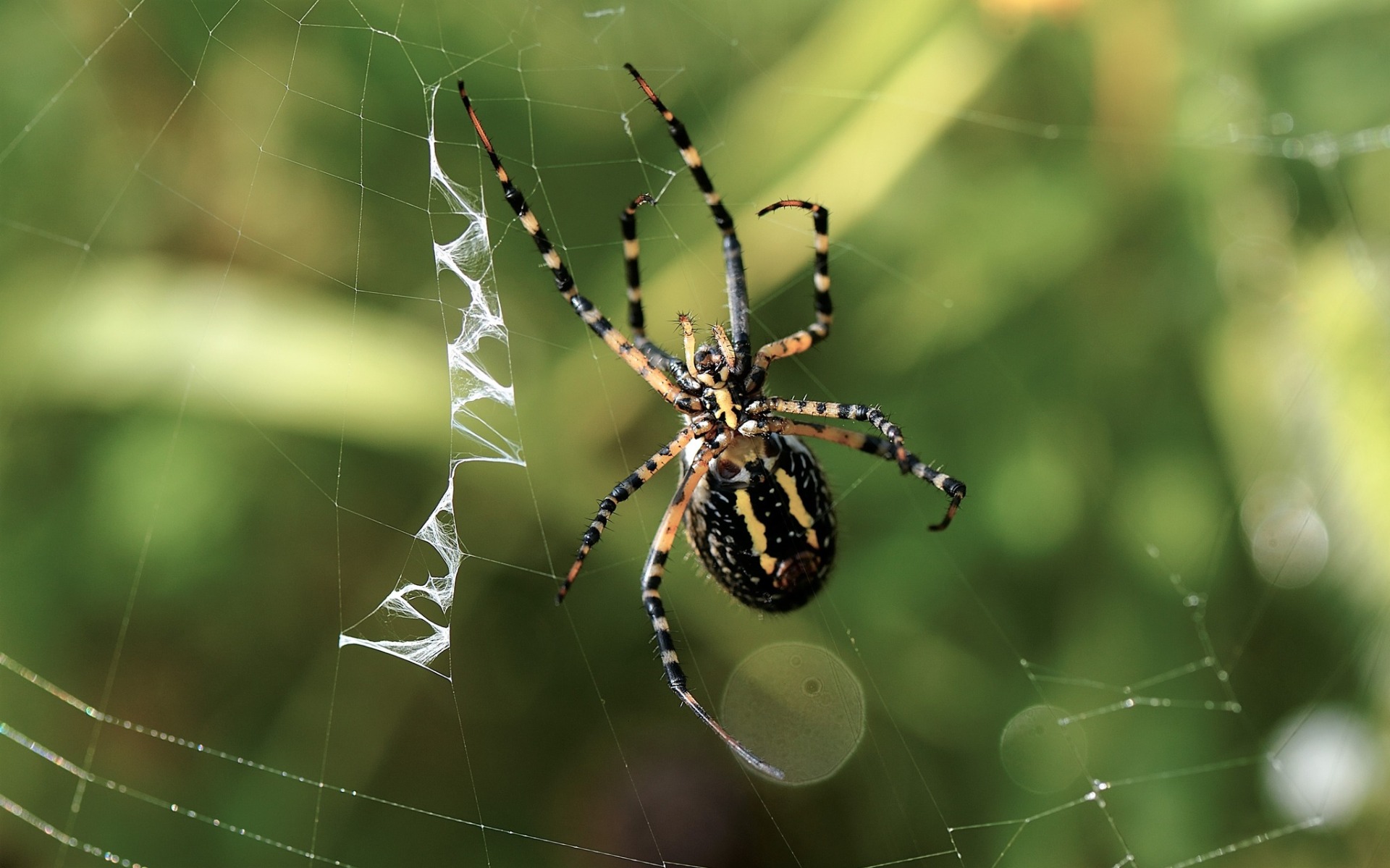With a Bright Face
Marla Mertz, Naturalist
As the north winds bring cool air, migration and dewy mornings, the glistening of spider webs seems to appear from out of nowhere. Those large, spiraled webs are dotted through the landscape like works of art. The most abundant of Iowa spiders are called Garden Spiders or Orb Weavers and are probably one of the most fascinating. They offer great benefits to our ecosystem by controlling numerous insect pests, are not aggressive and seem to flee immediately upon feeling threatened.
With open mind, let’s take a short venture to your nearest garden or wildlife area, camera or not, and take a peek at a few of Iowa’s Orb Weavers. Known for their colorful, intricately patterned abdomens, garden spiders are the common name for the genus Argiope, which means “with a bright face” in Latin. As a relative to an insect, there are some noticeable differences. At one time or another, we have probably learned that insects usually have six (6) legs and spiders have eight (8). Insects have three (3) main body parts (head, thorax, and abdomen) and spiders have two (2) body parts (the head and thorax fused together, called cephalothorax, and abdomen). Insects have antennae, normally two (2) pairs of wings and two (2) compound eyes with several simple eyes. Spiders have no antennae, no wings, and have 8 simple eyes, but no compound eyes.
Most eight-leggeds are not long-lived creatures. Depending on where you live, most orb weavers don’t live a full year. For the female, she may die at the first hard frost. She has probably mated, and her young may remain in the egg sac in a dormant state until the following spring. There is a high mortality rate to the egg sacs and are quite vulnerable to wasps, flies, and other insects. The male is also more of a traveler. During his travels, he may choose to court a female by ‘plucking’ at her web. Male weavers usually die after mating.
Spiders are unique as they spin silk from spinnerets on their abdomens. The orb weavers get their names by the shapes of their webs and are the infamous design for Halloween décor. They spin webs of smaller circles within larger circles, similar to spokes on a wheel. The spokes of the wheel usually go from the center outwards to their anchoring points, like a flower, stem, or leaf. Once the main structure of the web is complete, a sticky layer of silk is laid down in circles between the structured points. The spider uses one set of legs on the interior circle and one set on the next structural layer where the “sticky line” is created in the middle.
Some spin a thick zigzag pattern through the center of their webs. The scientific term for zigzag pattern is called the stabilimentum.
There are a few theories as to the purpose of the patterning, one being that it alerts predators by exaggerating their size; it may assist in the capture rate by adding sticky surfaces, but there are no proven theories about the zigzags. Whatever the reason, the intentional artwork has given the weavers another name, “the writing spider.”
These beautiful spiders give such great inspiration to keep revisiting their home, as their web may change daily. It can be a head-scratcher to unfold their little secrets. Windblown seeds and small insects in the web may appear to be untidy one day and be totally cleaned and repaired from the wind damage the next. It makes you wonder if they stayed up all night to clean their house or did something happen to them through the night? Surprise! Cool fact: They probably just ate their web from yesterday and created a new one today.
Whether it is in your backyard, a prairie, woodland, or roadside ditch, insects and spiders are more abundant than any other group of animals. They have a very important role to play in our environment and, undoubtedly, you will encounter a few along the way. With a curious mind some will find it absolutely fascinating to peek into their world. We don’t want to solve all mysteries and wonders but enjoy a little bit of their magic.
Attention educators and children! Do you like geometry? That might be a scary question for some of us, but there are some fun activities that can apply principles of geometry, architectural designs, and engineering all by learning and observing our backyard wildlife. Check out these links and learn from the orb weavers! Make your own observations and activities involving wind direction, temperature, angles, heights, direction of a spider’s abdomen and surface area covered. Please note that spiders and their webs should only be observed, not damaged and or harmed.
Learn more about spiders with the Project WILD Activity Guide – Project WILD is an interdisciplinary, supplementary environment and conservation education program for educators of kindergarten through high school young people.
-
- Spider Web Geometry: Math, Science, Language Arts, Art
- Interview A Spider: Discussion reading research, creative writing, interview
-
- Wild Kratts – Secrets of the Spiders Web (https://www.youtube.com/watch?v=KX2HzjI0XO4) – Storyline: Two miniaturized Kratts explore the world of the spider and how it creates its web, finding clues along the way that indicate what spider silk is made of that will help Aviva to replicate it.
-
- Spider Webs: “Math in the World Around Us: Spiderwebs and Geometry” by Adventure Academy. https://www.youtube.com/watch?v=zuIgXc0ZIts
-
- Keepers of the Animals, Native American Stories and Wildlife Activities for Children by Michael J. Caduto and Joseph Bruchac, Sticky Web activity, page 37 and other fun activities about webs and spiders. Great Books!
-
- Growing up wild - Spider Web Wonders – (https://www.fishwildlife.org/projectwild/growing-wild/resources/spider-web-wonders) Growing up Wild PreK-2nd Grade
-
- Iowa Public Radio Talk of Iowa with Charity Nebbe and Iowa State University Extension Entomologist Donald Lewis – Why certain insects are coming indoors this time of year. (https://www.iowapublicradio.org/podcast/talk-of-iowa/2021-11-06/heres-why-certain-insects-are-coming-indoors-this-time-of-year)
published Saturday, October 1, 2022



